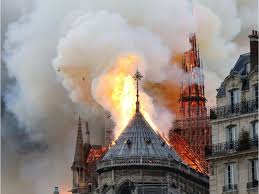Notre Dame Cathedral Restoration: An Analysis of Articles from TIME and Insider
On April 15th, 2019, the Notre Dame Cathedral caught on fire in Paris, France. Although there has not been any confirmed causes, it has been well received that the fire must have started in the attic of the cathedral, which was under renovation at the time. The actual source of the fire seems to be accidental, possibly by an electrical issue or human error, however there has not been any confirmations of these sources.
Considering that the Cathedral is often referred to as the "Heart of Paris," and is one of Paris' most popular tourist attractions, the fire undoubtedly caught the attention of millions all over the world. Some of which were wealthy millionaires whom decided to donate millions to help restore and rebuild the landmark. These donations have become a controversial topic in the news recently, as many people across the spectrum have a variety of mixed emotions and opinions towards them. The majority of these donations come from wealthy companies and people all across France and the United States. In order to analyze how these differing opinions coexist in language, I analyzed two different articles on the same topic by two different media companies, one from Insider, and one from TIME.
From my understanding, both articles seemed to be generally unbiased towards a certain political viewpoint on the topic. I took note that while neither articles seemed to have an actual opinion on the topic at hand, both had brought up the donations and funding previously made by organizations in France and in the U.S., in an attempt to refurbish the cathedral, previous to the fire. These references had no bias towards one donor or another, but thoroughly covered each company and foundation being mentioned, which I think shows a sense of professionalism and cohesiveness in their writing. Both articles did a decent job of straying away from using aspects of "decaying language," which I believe stood out the most to me, since I am used to seeing media companies use slang and or unprofessional language when discussing a controversial topic.
Although I was very underwhelmed by the contrast between these two media sources, as there was little to none in terms of language, I am under the impression that this is a result of both the sources at hand being neutral. By comparing two neutral sources, I had little to no language differences to compare, as part of being unbiased is stating only the facts and leaving no room for judgement or opinions. While I think these two articles were decent examples of neutral sources, I think it would have been more beneficial if I had found more opposing networks to analyze.



Comments
Post a Comment